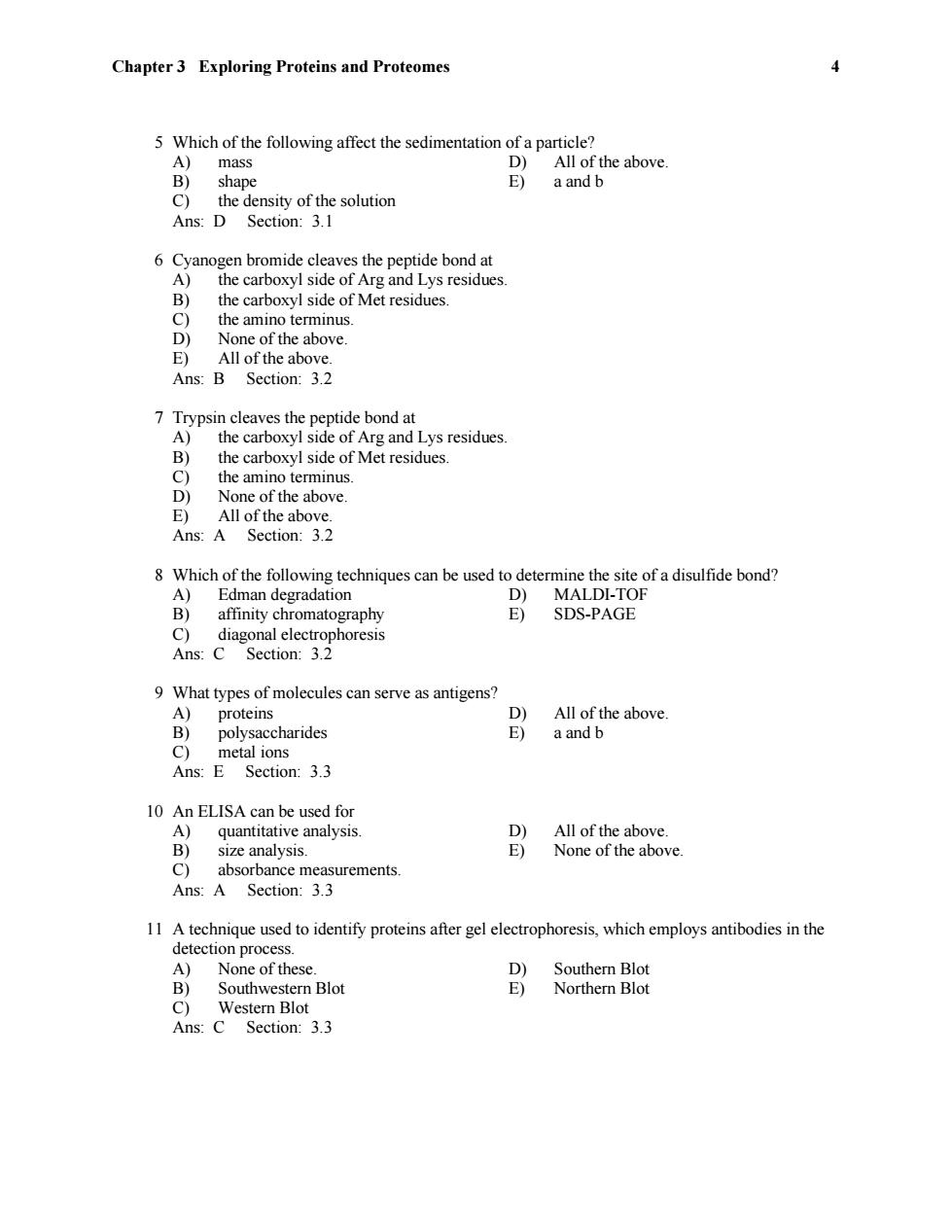正在加载图片...

Chapter 3 Exploring Proteins and Proteomes 4 5 Which of the following affect the sedimentation of a particle? A)mass D) All of the above. B)shape E) a and b C)the density of the solution Ans:D Section:3.1 6 Cyanogen bromide cleaves the peptide bond at A)the carboxyl side of Arg and Lys residues. B) the carboxyl side of Met residues. C) the amino terminus D)None of the above E)All of the above. Ans:B Section:3.2 7 Trypsin cleaves the peptide bond at A)the carboxyl side of Arg and Lys residues. B) the carboxyl side of Met residues. C) the amino terminus. D) None of the above. E)All of the above. Ans:A Section:3.2 8 Which of the following techniques can be used to determine the site of a disulfide bond? A) Edman degradation D MALDI-TOF B) affinity chromatography E) SDS-PAGE C)diagonal electrophoresis Ans:C Section:3.2 9 What types of molecules can serve as antigens? A) proteins D) All of the above. B) polysaccharides E) a and b C) metal ions Ans:E Section:3.3 10 An ELISA can be used for A)quantitative analysis. D) All of the above. B) size analysis. E) None of the above. C) absorbance measurements Ans:A Section:3.3 11 A technique used to identify proteins after gel electrophoresis,which employs antibodies in the detection process. A) None of these. D) Southern Blot B) Southwestern Blot E) Northern Blot C)Western Blot Ans:C Section:3.3Chapter 3 Exploring Proteins and Proteomes 4 5 Which of the following affect the sedimentation of a particle? A) mass D) All of the above. B) shape E) a and b C) the density of the solution Ans: D Section: 3.1 6 Cyanogen bromide cleaves the peptide bond at A) the carboxyl side of Arg and Lys residues. B) the carboxyl side of Met residues. C) the amino terminus. D) None of the above. E) All of the above. Ans: B Section: 3.2 7 Trypsin cleaves the peptide bond at A) the carboxyl side of Arg and Lys residues. B) the carboxyl side of Met residues. C) the amino terminus. D) None of the above. E) All of the above. Ans: A Section: 3.2 8 Which of the following techniques can be used to determine the site of a disulfide bond? A) Edman degradation D) MALDI-TOF B) affinity chromatography E) SDS-PAGE C) diagonal electrophoresis Ans: C Section: 3.2 9 What types of molecules can serve as antigens? A) proteins D) All of the above. B) polysaccharides E) a and b C) metal ions Ans: E Section: 3.3 10 An ELISA can be used for A) quantitative analysis. D) All of the above. B) size analysis. E) None of the above. C) absorbance measurements. Ans: A Section: 3.3 11 A technique used to identify proteins after gel electrophoresis, which employs antibodies in the detection process. A) None of these. D) Southern Blot B) Southwestern Blot E) Northern Blot C) Western Blot Ans: C Section: 3.3